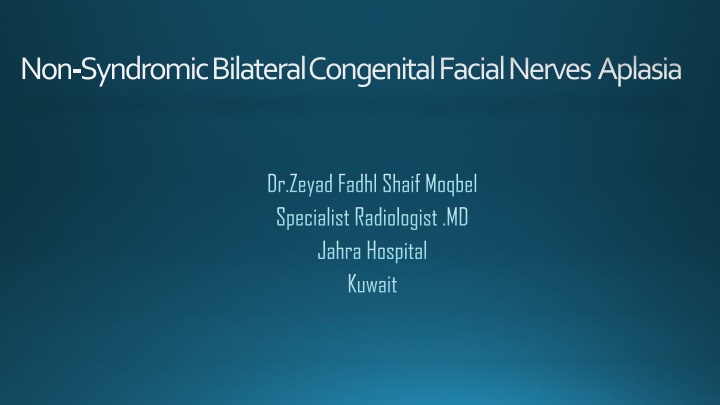
Rare Case of Bilateral Congenital Facial Nerve Aplasia
Learn about a rare case of non-syndromic bilateral congenital facial nerve aplasia in a two-year-old female infant, highlighting the importance of MRI in diagnosis and multidisciplinary care for optimal outcomes. Explore MRI findings and references on this condition.
Download Presentation

Please find below an Image/Link to download the presentation.
The content on the website is provided AS IS for your information and personal use only. It may not be sold, licensed, or shared on other websites without obtaining consent from the author. If you encounter any issues during the download, it is possible that the publisher has removed the file from their server.
You are allowed to download the files provided on this website for personal or commercial use, subject to the condition that they are used lawfully. All files are the property of their respective owners.
The content on the website is provided AS IS for your information and personal use only. It may not be sold, licensed, or shared on other websites without obtaining consent from the author.
E N D
Presentation Transcript
Non-Syndromic Bilateral Congenital Facial Nerves Aplasia Dr.ZeyadFadhlShaifMoqbel Specialist Radiologist .MD Jahra Hospital Kuwait
Case synopsis Facial nerve aplasia is an extremely rare condition that is usually syndromic, namely; in Moebius syndrome, among others. The occurrence of isolated aplasia of facial nerve is even rarer, with only few cases reported in the literature. It is classified as traumatic or developmental; unilateral or bilateral; and complete or incomplete In our case we report a two-year-old female infant with bilateral congenital facial nerve palsy. The condition was noted at birth, manifesting as facial asymmetry during crying and an inability to close both eyes completely. The patient was born at term with vaginal delivery, with no history of perinatal trauma, birth asphyxia, or the use of instrumentation. Family history was unremarkable, and developmental milestones were appropriate for age. On examination, bilateral lower motor neuron facial nerve palsy was confirmed, with the absence of dysmorphic features or other cranial nerve involvement. High-resolution MRI revealed bilateral aplasia of the facial nerves. Other cranial nerves, including the cochlear and vestibular nerves, as well as the abducent nerves were intact. Physiotherapy is the mainstay of treatment. Most patients regain some function in follow-up which may be due to aberrant innervations of some of the facial muscles by other cranial nerves This case highlights the importance MRI in diagnosing congenital facial nerve aplasia and emphasizes the need for early multidisciplinary care to optimize outcomes in this rare condition.
MRI FINDINGS: Vestibular N Cochlear N Vestibular N Cochlear N B A MRI Sagittal oblique FIESTA right (A)and left(B) of the IAC revealed absence of both facial nerves (red arrows) . MRI Axial T2 FIESTA Intact both abducent nerves(black arrows) , a finding excluding Moebius syndrome.
References 1.Nordjoe YE, AzdadO, LahkimM, JroundiL, LaamraniFZ. Congenital unilateral facial palsy revealing a facial nerve agenesis: a case report and review of the literature. BJR Case Reports. 2019;5(1):20180029. doi:10.1259/bjrcr.20180029. 2.Kumar I, Verma A, Ojha R, Aggarwal P. Congenital facial nerve aplasia: MR depiction of a rare anomaly. Indian J RadiolImaging. 2016;26(4):517-520. doi:10.4103/0971-3026.195791. 3.Jervis PN, Bull PD. Congenital facial nerve agenesis. J LaryngolOtol. 2001;115(1):53-54. doi:10.1258/0022215011906795.
